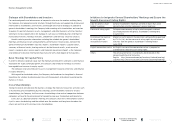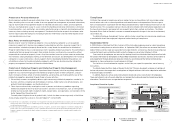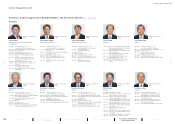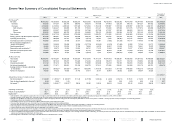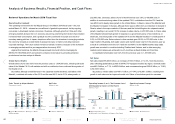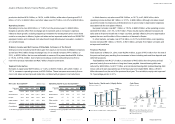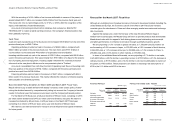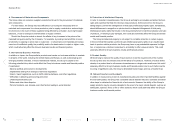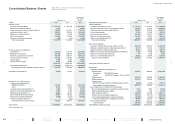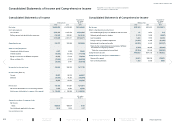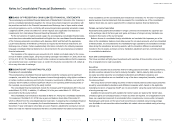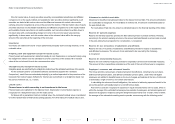Mazda 2016 Annual Report Download - page 47
Download and view the complete annual report
Please find page 47 of the 2016 Mazda annual report below. You can navigate through the pages in the report by either clicking on the pages listed below, or by using the keyword search tool below to find specific information within the annual report.
Signifi cant risks that could affect the Mazda Group’s business results and fi nancial position
include those listed below.
This list, however, shows the main risks anticipated at the end of the fi scal year ended
March 31, 2016, and does not represent a comprehensive list of all the risks faced by the
Group. The forward-looking statements in this section are based on the judgments of the
Group as of the end of the fi scal year ended March 31, 2016.
1. Economic Conditions Impacting the Mazda Group
Selling its products in Japan and other parts of the world, including in North America, Europe,
and Asia, the Group is greatly impacted by economic trends and fl uctuations in demand in
each of its markets. Therefore, the Group’s business results and fi nancial position could be
adversely affected by, for example, an economic downturn, recession, changes in demand
structure, declining demand, and intensifying price competition in its main markets.
2. Fluctuations in Exchange Rates
The Group is engaged in business activities on a global scale. The Group not only exports
products from Japan to other parts of the world but also exports products manufactured at
overseas plants to other markets in the world. These transactions are conducted in various
currencies, and consequently its business results and fi nancial position are exposed to the
effects of fl uctuations in exchange rates. In addition, as overseas assets and liabilities
denominated in local currencies are translated into yen, there could be an adverse effect
on shareholders’ equity through foreign currency translation adjustments due to exchange
rate fl uctuations.
The Group uses forward-exchange contracts and other instruments to minimize the impact
of short-term exchange rate risk. However, depending on the circumstances of fl uctuations in
exchange rates, loss of opportunity could be generated.
3. Alliances and Joint Ventures
The Group is performing or examining joint activities with other companies under technology
alliances, joint ventures, and in other forms with respect to the development, production, and
sales of products. These joint activities are designed to optimize resources, facilitate their
prioritization, and generate synergies. However, in the event of a disagreement over manage-
ment, fi nancial, or other matters between the parties involved, or in the event that the
expected results were not produced due to such factors as changes to or terminations of
alliances and joint ventures, the Group’s business results and fi nancial position could be
adversely affected. In addition, unintended changes to or terminations of alliances and joint
ventures could have an adverse effect on the Group’s business results and fi nancial position.
4. Statutory Regulations Covering the Environment
In addition to being subject to environmental regulations pertaining to fuel consumption and
exhaust emissions, automobile safety, and the pollutant emission levels from manufacturing
plants, the Group’s operations in each country where it does business are subject to various
statutory regulations, such as labor regulations.
Going forward, the Group’s business results and fi nancial position could be adversely
affected by the increased costs associated with more stringent statutory regulations.
5. Market Competitiveness
The Group competes with a large number of companies in automobile markets in all parts of
the world. Maintaining and enhancing the Group’s ability to compete in these markets, which
includes maintaining and developing Mazda brand value, is crucial to ensuring growth.
Consequently, the Group is implementing a range of initiatives to boost its competitiveness in
product development, manufacturing, sales, and other areas.
However, the Group’s business results and fi nancial position could be affected in the event
that it fails to launch appealing products at opportune times, due to a failure to accurately
ascertain market trends or as a result of issues related to technological capabilities and
manufacturing. The same holds true if the Group fails to take effective steps to respond to
customer values or changes thereof, including declines in market share or product prices,
through its dealership network or sales methods.
Business Risks
MAZDA ANNUAL REPORT 2016
45 Financial Section
Message from
Management
Review of Operations
Drivers of Value Creation
Foundations Underpinning
Sustainable Growth
Contents


